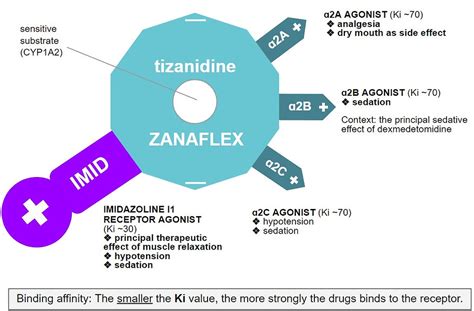Intro
Discover the uses and benefits of Tizanidine for muscle spasticity relief. Learn how this muscle relaxant works to alleviate symptoms of multiple sclerosis, spinal cord injuries, and stroke. Explore its efficacy, dosage, and potential side effects, and find out if Tizanidine is right for you in managing muscle stiffness and spasms.
Muscle spasticity is a condition characterized by involuntary muscle contractions, stiffness, and spasms. It can be caused by various factors, including stroke, multiple sclerosis, spinal cord injury, and cerebral palsy. Muscle spasticity can significantly impact an individual's quality of life, making everyday activities challenging and painful. Fortunately, there are several treatment options available to manage muscle spasticity, and Tizanidine is one of them.
Tizanidine, also known by its brand name Zanaflex, is a muscle relaxant medication that has been widely used to treat muscle spasticity. It is an alpha-2 adrenergic agonist, which means it works by stimulating the alpha-2 receptors in the brain and spinal cord, leading to a decrease in muscle tone and spasms. In this article, we will delve into the uses and benefits of Tizanidine for muscle spasticity relief, as well as its mechanism of action, side effects, and potential interactions.
How Tizanidine Works

Tizanidine works by binding to alpha-2 adrenergic receptors in the brain and spinal cord. This binding action triggers a decrease in the release of excitatory neurotransmitters, such as glutamate and aspartate, which are responsible for transmitting signals that cause muscle contractions. As a result, Tizanidine reduces muscle tone and spasms, leading to relief from muscle spasticity.
Uses of Tizanidine
Tizanidine is primarily used to treat muscle spasticity caused by various conditions, including:
- Multiple sclerosis
- Spinal cord injury
- Stroke
- Cerebral palsy
- Traumatic brain injury
Tizanidine can be used alone or in combination with other medications to manage muscle spasticity. It is available in tablet and capsule forms and can be administered orally.
Benefits of Tizanidine
Tizanidine offers several benefits for individuals with muscle spasticity, including:
- Rapid relief from muscle spasms and stiffness
- Improved muscle tone and reduced muscle contractions
- Enhanced mobility and flexibility
- Reduced pain and discomfort
- Improved sleep quality
Side Effects of Tizanidine

Like any medication, Tizanidine can cause side effects, some of which are common and mild, while others are rare and severe. Common side effects of Tizanidine include:
- Drowsiness and sedation
- Dizziness and lightheadedness
- Headache
- Fatigue
- Dry mouth
- Nausea and vomiting
Rare but severe side effects of Tizanidine include:
- Hallucinations
- Confusion and disorientation
- Abnormal heart rhythms
- Low blood pressure
- Liver damage
Interactions with Other Medications
Tizanidine can interact with other medications, including:
- Fluvoxamine (Luvox)
- Ciprofloxacin (Cipro)
- Acetaminophen (Tylenol)
- Aspirin
- Warfarin (Coumadin)
It is essential to inform your doctor about all the medications you are taking, including prescription and over-the-counter medications, before starting Tizanidine.
Precautions and Contraindications
Tizanidine is contraindicated in individuals with:
- Hypersensitivity to Tizanidine or its ingredients
- Liver disease
- Kidney disease
- Heart disease
Tizanidine should be used with caution in individuals with:
- History of seizures
- History of depression
- History of anxiety
- Pregnancy or breastfeeding
Dosage and Administration
Tizanidine is available in tablet and capsule forms, and the dosage varies depending on the individual's condition and response to treatment. The typical starting dose of Tizanidine is 4 mg, which can be increased gradually to a maximum dose of 36 mg per day.
Conclusion
Tizanidine is a muscle relaxant medication that has been widely used to treat muscle spasticity. Its mechanism of action, benefits, and side effects make it an effective treatment option for individuals with muscle spasticity. However, it is essential to use Tizanidine under the guidance of a healthcare professional and to be aware of its potential interactions with other medications.
What is Tizanidine used for?
+Tizanidine is used to treat muscle spasticity caused by various conditions, including multiple sclerosis, spinal cord injury, stroke, cerebral palsy, and traumatic brain injury.
How does Tizanidine work?
+Tizanidine works by binding to alpha-2 adrenergic receptors in the brain and spinal cord, leading to a decrease in muscle tone and spasms.
What are the common side effects of Tizanidine?
+Common side effects of Tizanidine include drowsiness, dizziness, headache, fatigue, dry mouth, and nausea.
If you have any questions or concerns about Tizanidine or muscle spasticity, please share them in the comments section below. We would be happy to help.
